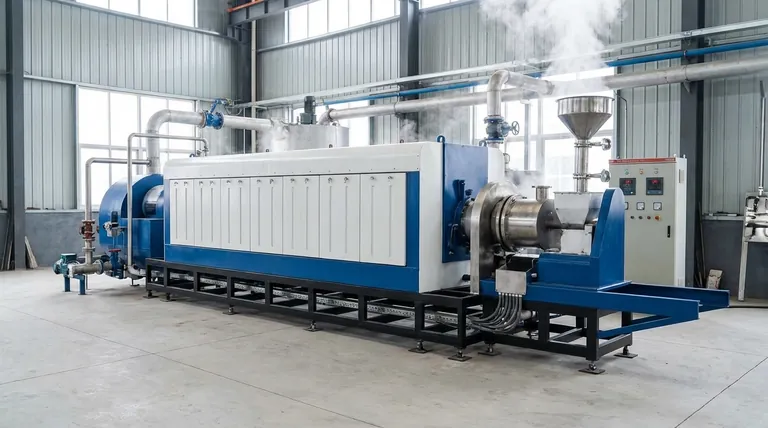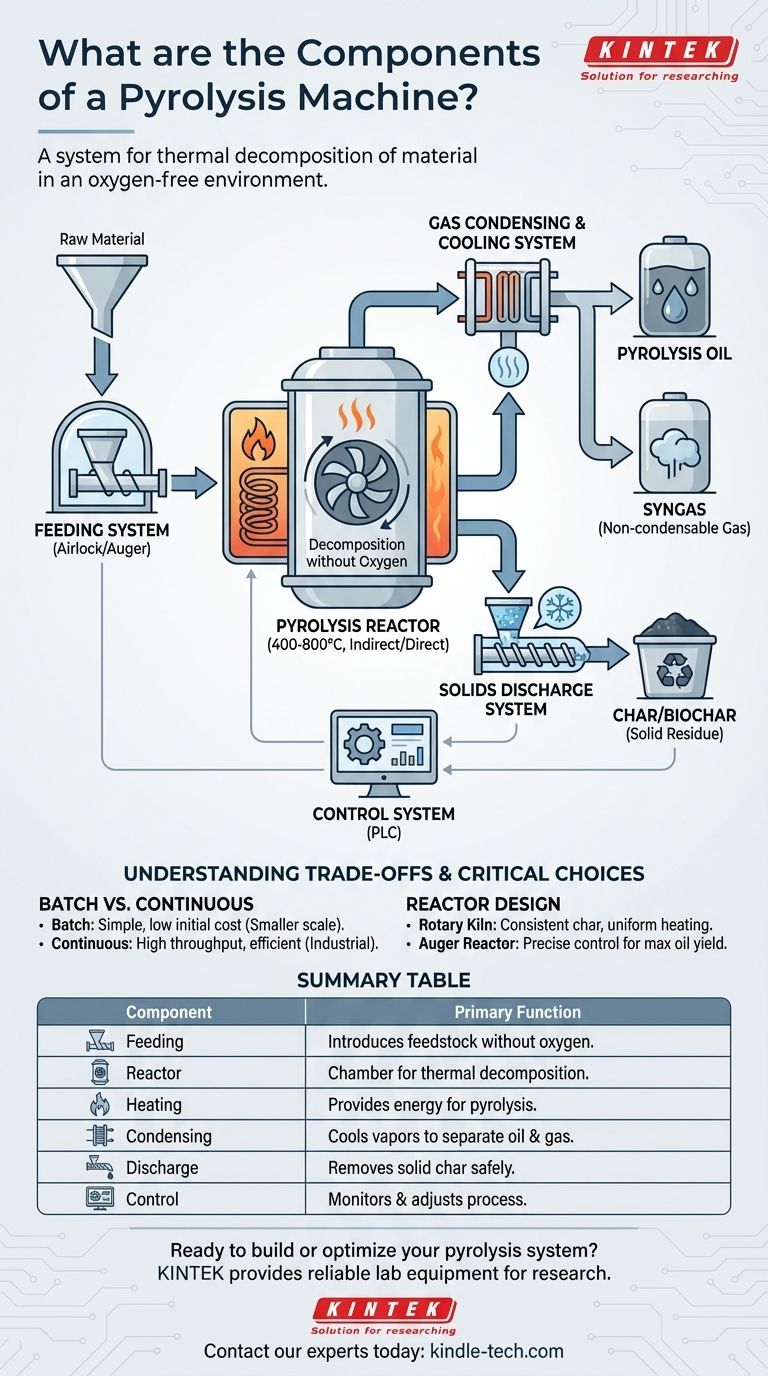At its core, a pyrolysis machine is a system of integrated components designed to thermally decompose material in an oxygen-free environment. The primary components include an airtight feeding system, a central reactor, an external heating system, a gas condensing and cooling system to separate liquids and gases, and a discharge system for the solid char.
A pyrolysis machine is not just a single piece of equipment, but an entire process line. Understanding how each component functions and interacts is the key to controlling the process, ensuring safety, and achieving the desired output products, whether that's oil, gas, or char.

The Core Components: A Step-by-Step Breakdown
A pyrolysis system can be understood by following the path of the material from raw feedstock to finished products. Each stage is managed by a specific set of components with a critical function.
The Feeding System: Controlling the Input
The feeding system introduces raw material into the reactor. Its most critical job is to do this without allowing oxygen to enter the system, as oxygen would cause combustion instead of pyrolysis.
Common designs include sealed screw feeders (augers) or double-gate airlock valves. For continuous operation, this component's reliability is paramount to maintaining process stability and safety.
The Pyrolysis Reactor: The Heart of the Process
The reactor is the sealed chamber where the material is heated and the chemical decomposition occurs. The design of the reactor is the single most important factor determining the system's efficiency and the characteristics of the end products.
Different types exist, each with unique heat transfer and material handling properties. Common designs include rotary kilns, which tumble the material for even heating, and auger reactors, which use a screw to convey material through a heated tube.
The Heating System: Driving the Reaction
The heating system provides the energy required to bring the feedstock to pyrolysis temperatures, typically between 400°C and 800°C. This system is distinct from the reactor itself.
Heating can be indirect, where the reactor chamber is heated from the outside, or direct, where hot gases or other media are passed through the material. Heat is often generated by burning a portion of the non-condensable syngas produced by the process, creating a self-sustaining loop.
The Gas Condensing and Cooling System: Capturing the Value
As the material decomposes, it releases a hot mixture of vapors and gases. This stream is directed to a condensing and cooling system.
Here, heat exchangers or other cooling mechanisms lower the temperature of the gas stream. This causes the heavier, long-chain hydrocarbon vapors to condense into a liquid (pyrolysis oil), while the lighter, non-condensable gases (syngas) remain in a gaseous state. This separation is crucial for product recovery.
The Solids Discharge System: Handling the Byproduct
The solid residue left after pyrolysis, known as char or biochar, must be removed from the reactor.
Like the feeding system, the discharge system must be sealed to prevent hot char from being exposed to oxygen, which would cause it to ignite. This is often accomplished with a cooled screw conveyor that transports the char to a sealed collection bin.
The Control System: The Brain of the Operation
Modern pyrolysis plants are governed by a Programmable Logic Controller (PLC). This system monitors and adjusts a network of sensors measuring temperature, pressure, and flow rates.
An effective control system is essential for ensuring operational safety, maintaining consistent product quality, and optimizing energy efficiency.
Understanding the Trade-offs and Critical Choices
Simply listing components is not enough; the choice and integration of these parts involve significant trade-offs that dictate the system's performance and cost.
Batch vs. Continuous Systems
A batch system is simpler and has a lower initial cost. You load it, run the process, let it cool, and unload it. This is suitable for smaller-scale operations or research.
A continuous system offers much higher throughput and greater efficiency but is mechanically more complex and requires a significant capital investment. The feeding and discharge systems are far more critical and sophisticated in a continuous design.
Reactor Design and Heat Transfer
The choice of reactor directly impacts the final product. A rotary kiln provides excellent mixing and uniform heating, which is ideal for producing a consistent char.
An auger reactor offers precise control over residence time (how long the material stays in the heat), which can be manipulated to maximize liquid oil yield. Inefficient heat transfer in any design leads to incomplete pyrolysis and lower-quality products.
Safety and Emissions Control
Pyrolysis produces flammable syngas, which must be managed carefully. A robust safety system includes pressure relief valves and an emergency flare to safely burn off excess gas.
Furthermore, any uncondensed syngas that isn't used for heating must be properly handled. This may involve flaring or passing it through emissions control equipment (a "scrubber") to comply with environmental regulations.
Selecting Components for Your Goal
Your choice of pyrolysis components should be driven entirely by your primary objective.
- If your primary focus is maximizing liquid oil yield: You need a system with rapid heating and an efficient, fast-quenching condensation unit to capture vapors before they break down further.
- If your primary focus is producing high-quality biochar: You should prioritize a reactor that allows for slower heating rates and longer residence times, such as a rotary kiln.
- If your primary focus is high-throughput industrial waste processing: A fully automated, continuous system with a robust auger or kiln reactor is the only viable path.
- If your primary focus is operational simplicity and lower capital cost: A batch-style system with a fixed-bed or simple drum reactor is the most straightforward and economical approach.
By understanding that a pyrolysis machine is a goal-oriented system, you can evaluate and select the right configuration to achieve your specific chemical or business objectives.
Summary Table:
| Component | Primary Function | Key Feature |
|---|---|---|
| Feeding System | Introduces feedstock without oxygen | Sealed screw feeders or airlock valves |
| Reactor | Chamber for thermal decomposition | Rotary kiln or auger design for heat transfer |
| Heating System | Provides energy for pyrolysis (400-800°C) | Indirect or direct; often uses syngas |
| Condensing System | Cools vapors to separate oil and gas | Heat exchangers for efficient quenching |
| Discharge System | Removes solid char safely | Cooled screw conveyor to prevent ignition |
| Control System (PLC) | Monitors and adjusts process parameters | Ensures safety, quality, and efficiency |
Ready to build or optimize your pyrolysis system? The right components are critical for achieving your target product yield, whether it's high-quality biochar, maximum liquid oil, or high-throughput waste processing. KINTEK specializes in providing reliable lab equipment and consumables for pyrolysis research and development. Our expertise can help you select the perfect configuration for your specific chemical or business objectives. Contact our experts today to discuss your project and ensure operational safety and efficiency!
Visual Guide

Related Products
- Electric Rotary Kiln Small Rotary Furnace Biomass Pyrolysis Plant
- Customizable High Pressure Reactors for Advanced Scientific and Industrial Applications
- Mini SS High Pressure Autoclave Reactor for Laboratory Use
- High Pressure Laboratory Autoclave Reactor for Hydrothermal Synthesis
- Electric Rotary Kiln Continuous Working Small Rotary Furnace Heating Pyrolysis Plant
People Also Ask
- What are the different types of pyrolysis machines? Choose the Right System for Your Output
- What is a disadvantage of biomass energy? The Hidden Environmental and Economic Costs
- Is pyrolysis viable? A Guide to Economic, Technological, and Environmental Success
- What are the components of biomass pyrolysis? A Complete Guide to the System, Products, and Process
- What is the process of biomass fast pyrolysis? Turn Biomass into Bio-Oil in Seconds



















